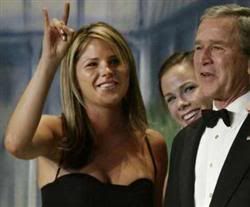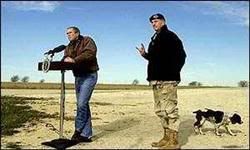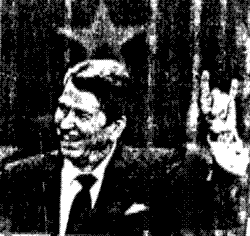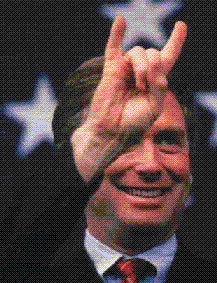Cleanup of 9/11 Dust to Resume, E.P.A. Says, Despite Widespread Criticism
ANTHONY DePALMA
NY Times
Thursday, December 7, 2006
More than five years after contaminated dust from the World Trade Center seeped into apartments and offices throughout Lower Manhattan, the federal Environmental Protection Agency announced plans yesterday to start a final indoor cleanup program next month, despite widespread criticism that the program is seriously flawed.
Agency officials said residents and owners of commercial buildings below Canal Street would have 60 days to sign up for the voluntary program, which will test for asbestos, lead, vitreous fibers and harmful soot that may have come from the collapse of the trade center.
If any one of the contaminants is found, the space will be professionally cleaned at no cost to the resident or owner.
The new program is almost identical to one that was rejected in November 2005 as inadequate by the agency’s advisory panel of experts as well as by community groups, labor unions and the city’s Congressional delegation. The City Council passed a resolution condemning that program, calling it “technically and scientifically flawed.”
Senator Hillary Rodham Clinton, who in 2004 forced the environmental agency to test indoor spaces for contamination, called the program announced yesterday “totally inadequate.”
In a statement, she said she would use her chairmanship of the Senate Subcommittee on Superfund and Environmental Health in the new Congress to press for a more comprehensive testing and cleaning program.
In early 2005, the agency considered creating a far broader program that would have used statistically based mapping to learn the extent of the contamination, following it outside Manhattan if needed. Under that program, if any dust could be conclusively linked to the trade center collapse, entire buildings, not individual apartments or offices, were to be vacuumed and wiped down to prevent recontamination from spaces that had not been cleaned.
The agency abandoned that program late last year when it could not devise a reliable way to identify trade center dust. It substituted a pared down program that would only test individual apartments in Lower Manhattan and clean only those where contamination was found. However, when community residents objected to the program as insufficient, the agency agreed to continue looking for a method of identifying dust from the twin towers.
Yesterday, Alan J. Steinberg, regional administrator for the agency, said that effort had taken most of the last year but had failed to come up with a viable method.
Last year’s program has been modified to include commercial spaces and to allow previously cleaned apartments to be retested, but it still excludes Brooklyn and is restricted to Lower Manhattan below Canal Street.
Catherine McVay Hughes, a downtown resident who was community liaison on the agency’s advisory panel, said she was disturbed that the agency had not notified residents of this latest version before announcing it. She said it was still so limited that it was unlikely to accomplish Mr. Steinberg’s goal of providing “peace of mind to people who live and work in Lower Manhattan.”
“Because the plan continues to be inadequate, I can’t imagine that there will be much of a response,” she said.
Paul J. Lioy, an environmental scientist at Rutgers who was also a member of the advisory panel, said the program, though flawed, could do some good.
“At least something is finally being done,” he said. “If there is residual dust, we’ll be able to find it.”
It is not clear how many apartments and commercial spaces can be cleaned under the new program. Mr. Steinberg said only $7 million was left from a Federal Emergency Management Agency grant to pay for the new cleanup. A previous effort in 2002 and 2003 that cleaned or tested 4,200 of more than 23,000 apartments in Lower Manhattan cost $30 million.
Mr. Steinberg said testing for the four contaminants would cost about $3 a square foot, or $3,000 for an average apartment, while cleaning that same space will add an additional $1 per square foot.
But officials said they expected the testing to show that most apartments do not need to be cleaned.
“The danger really is low,” said George M. Gray, assistant administrator for the agency’s Office of Research and Development. “The vast majority of occupied residential and commercial spaces have been repeatedly cleaned since 2001.”
Dr. Gray said the normal process of household cleaning — dusting and vacuuming and the like — has probably eliminated most of the dust that infiltrated indoor spaces.
Environmental advocates disagreed. “That’s not an environmental cleanup,” said Suzanne Mattei, director of the Sierra Club’s New York office. “Most experts say that if a carpet really is contaminated with asbestos, you probably need to get it out of the house altogether.”
The 60-day sign-up period for the voluntary cleanup program will begin in January, and testing is expected to start in the spring. More information is available online at epa.gov/wtc/testandclean.
NY Times
Thursday, December 7, 2006
More than five years after contaminated dust from the World Trade Center seeped into apartments and offices throughout Lower Manhattan, the federal Environmental Protection Agency announced plans yesterday to start a final indoor cleanup program next month, despite widespread criticism that the program is seriously flawed.
Agency officials said residents and owners of commercial buildings below Canal Street would have 60 days to sign up for the voluntary program, which will test for asbestos, lead, vitreous fibers and harmful soot that may have come from the collapse of the trade center.
If any one of the contaminants is found, the space will be professionally cleaned at no cost to the resident or owner.
The new program is almost identical to one that was rejected in November 2005 as inadequate by the agency’s advisory panel of experts as well as by community groups, labor unions and the city’s Congressional delegation. The City Council passed a resolution condemning that program, calling it “technically and scientifically flawed.”
Senator Hillary Rodham Clinton, who in 2004 forced the environmental agency to test indoor spaces for contamination, called the program announced yesterday “totally inadequate.”
In a statement, she said she would use her chairmanship of the Senate Subcommittee on Superfund and Environmental Health in the new Congress to press for a more comprehensive testing and cleaning program.
In early 2005, the agency considered creating a far broader program that would have used statistically based mapping to learn the extent of the contamination, following it outside Manhattan if needed. Under that program, if any dust could be conclusively linked to the trade center collapse, entire buildings, not individual apartments or offices, were to be vacuumed and wiped down to prevent recontamination from spaces that had not been cleaned.
The agency abandoned that program late last year when it could not devise a reliable way to identify trade center dust. It substituted a pared down program that would only test individual apartments in Lower Manhattan and clean only those where contamination was found. However, when community residents objected to the program as insufficient, the agency agreed to continue looking for a method of identifying dust from the twin towers.
Yesterday, Alan J. Steinberg, regional administrator for the agency, said that effort had taken most of the last year but had failed to come up with a viable method.
Last year’s program has been modified to include commercial spaces and to allow previously cleaned apartments to be retested, but it still excludes Brooklyn and is restricted to Lower Manhattan below Canal Street.
Catherine McVay Hughes, a downtown resident who was community liaison on the agency’s advisory panel, said she was disturbed that the agency had not notified residents of this latest version before announcing it. She said it was still so limited that it was unlikely to accomplish Mr. Steinberg’s goal of providing “peace of mind to people who live and work in Lower Manhattan.”
“Because the plan continues to be inadequate, I can’t imagine that there will be much of a response,” she said.
Paul J. Lioy, an environmental scientist at Rutgers who was also a member of the advisory panel, said the program, though flawed, could do some good.
“At least something is finally being done,” he said. “If there is residual dust, we’ll be able to find it.”
It is not clear how many apartments and commercial spaces can be cleaned under the new program. Mr. Steinberg said only $7 million was left from a Federal Emergency Management Agency grant to pay for the new cleanup. A previous effort in 2002 and 2003 that cleaned or tested 4,200 of more than 23,000 apartments in Lower Manhattan cost $30 million.
Mr. Steinberg said testing for the four contaminants would cost about $3 a square foot, or $3,000 for an average apartment, while cleaning that same space will add an additional $1 per square foot.
But officials said they expected the testing to show that most apartments do not need to be cleaned.
“The danger really is low,” said George M. Gray, assistant administrator for the agency’s Office of Research and Development. “The vast majority of occupied residential and commercial spaces have been repeatedly cleaned since 2001.”
Dr. Gray said the normal process of household cleaning — dusting and vacuuming and the like — has probably eliminated most of the dust that infiltrated indoor spaces.
Environmental advocates disagreed. “That’s not an environmental cleanup,” said Suzanne Mattei, director of the Sierra Club’s New York office. “Most experts say that if a carpet really is contaminated with asbestos, you probably need to get it out of the house altogether.”
The 60-day sign-up period for the voluntary cleanup program will begin in January, and testing is expected to start in the spring. More information is available online at epa.gov/wtc/testandclean.












0 Comments:
Post a Comment
<< Home